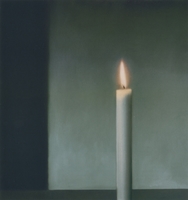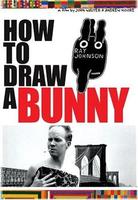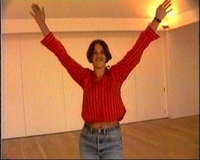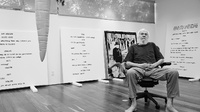Items
Tag
Experimental
-
 Kerse (Candle) Gerhard Richter did a series of still life candles from his own photos in the early 1980’s. The link below describes the importance of Richter's work. Candle was used on Daydream Nation by Sonic Youth.
Kerse (Candle) Gerhard Richter did a series of still life candles from his own photos in the early 1980’s. The link below describes the importance of Richter's work. Candle was used on Daydream Nation by Sonic Youth. -
 How to Draw a Bunny Ray Johnson was a mystery wrapped in an enigma who lived his life like a Pop Art performance piece. His final masterpiece may well have been his own death, in January 1995. This enthralling documentary – edited and directed by John Walter, photographed and produced by Andrew Moore – is at once playful and haunting, an in-depth portrait of an iconoclastic artist who was fundamentally unknowable even to his closest friends. Dubbed “the most famous unknown artist in America” in his time, Johnson is a prime example of the underground, eccentric genius who remains unknown to the public at large, while being legendary among his peers and others “in the know.” Many luminaries of the modern art world counted themselves fans and friends of Johnson, and “How to Draw a Bunny” features priceless interviews with such masters as Roy Lichtenstein, James Rosenquist, Chuck Close and Christo. Some marvel at the elusive complexity of Johnson’s art – a series of increasingly intricate letters to agent Mort Janklow is one example – while others conclude that he was most likely from another planet altogether. But none can separate the man from his work – his whole existence was his art, and his concepts of what an artwork could be were an (uncredited, of course) influence on the acknowledged father of Pop Art, one Andy Warhol. As Warhol Factory denizen Billy Name opines, “Ray wasn’t a person, he was a collage or a sculpture…he was Ray Johnson’s creation.” In the late ’80s, Johnson fortuitously added video to his palette. Some of that footage is included here, though much of it consists of Johnson going to a cocktail party, putting the guests on, making all of them part of his ongoing biographical “piece.” Johnson always seemed to have a sense of humor about what he was doing, and in the film he never once comes across as pretentious (as so much of the New York scene at the time did). This enigmatic whimsy extended to Johnson’s death, likely a suicide. His body was found floating under the Sag Harbor bridge, by buoy number 13. It was the 13th of January, and Johnson had stayed the night before in a motel, room number 247 (which adds up to 13). He was 67 at the time of his death (which also adds up to 13). In astounding video footage shot after his death, we see that Johnson had deliberately arranged his entire house to be discovered as his last great artwork, a meticulous warehouse of his ideas, his obsessions. Then again, maybe “How to Draw a Bunny” itself is really Ray Johnson’s final testament, created with a mischievous wink from beyond the grave. After watching this extraordinary documentary, one has no doubt that such an act is well within Johnson’s creative powers.
How to Draw a Bunny Ray Johnson was a mystery wrapped in an enigma who lived his life like a Pop Art performance piece. His final masterpiece may well have been his own death, in January 1995. This enthralling documentary – edited and directed by John Walter, photographed and produced by Andrew Moore – is at once playful and haunting, an in-depth portrait of an iconoclastic artist who was fundamentally unknowable even to his closest friends. Dubbed “the most famous unknown artist in America” in his time, Johnson is a prime example of the underground, eccentric genius who remains unknown to the public at large, while being legendary among his peers and others “in the know.” Many luminaries of the modern art world counted themselves fans and friends of Johnson, and “How to Draw a Bunny” features priceless interviews with such masters as Roy Lichtenstein, James Rosenquist, Chuck Close and Christo. Some marvel at the elusive complexity of Johnson’s art – a series of increasingly intricate letters to agent Mort Janklow is one example – while others conclude that he was most likely from another planet altogether. But none can separate the man from his work – his whole existence was his art, and his concepts of what an artwork could be were an (uncredited, of course) influence on the acknowledged father of Pop Art, one Andy Warhol. As Warhol Factory denizen Billy Name opines, “Ray wasn’t a person, he was a collage or a sculpture…he was Ray Johnson’s creation.” In the late ’80s, Johnson fortuitously added video to his palette. Some of that footage is included here, though much of it consists of Johnson going to a cocktail party, putting the guests on, making all of them part of his ongoing biographical “piece.” Johnson always seemed to have a sense of humor about what he was doing, and in the film he never once comes across as pretentious (as so much of the New York scene at the time did). This enigmatic whimsy extended to Johnson’s death, likely a suicide. His body was found floating under the Sag Harbor bridge, by buoy number 13. It was the 13th of January, and Johnson had stayed the night before in a motel, room number 247 (which adds up to 13). He was 67 at the time of his death (which also adds up to 13). In astounding video footage shot after his death, we see that Johnson had deliberately arranged his entire house to be discovered as his last great artwork, a meticulous warehouse of his ideas, his obsessions. Then again, maybe “How to Draw a Bunny” itself is really Ray Johnson’s final testament, created with a mischievous wink from beyond the grave. After watching this extraordinary documentary, one has no doubt that such an act is well within Johnson’s creative powers. -
 Why I Never Became a Dancer Emin uses her emotional life as the source and subject matter of her art. This takes the form of narrative or documentation of traumatic events such as the death of a family member or close friend, her rape and her abortions, coupled with the direct expression of such feelings as love, hate, anger, fear and desire. Autobiographical and diaristic texts appear on her monoprints, her quilt-like wall hangings and in small publications such as Explorations of the Soul 1994 (an edition of 200); or they are narrated aloud, as in this video. Her artistic production could be seen as an attempt to find a therapeutic resolution to her damaged past and the continuing difficulties and frustrations of the present. This creative attitude is encapsulated in words appliquéed on a chair she inherited from her grandmother: 'It's not what you inherit. It's what you do with your inheritance.' By sharing thoughts and feelings of the type for which people are generally made to feel ashamed, Emin taps into collective experience in an affirmative way. Why I Never Became a Dancer was made in an edition of ten. It invokes the artist's early teenage years spent kicking against the boredom of the seaside town, Margate, where she grew up, and experimenting with sex from an early age until she became disillusioned with men and turned instead to dancing. Beginning with the title words written large on a wall, the camera pans around views of Margate significant to Emin's past, including the school she attended, the sea front, shopping arcades and a dramatic clock tower. This sequence is overlaid with the voice of the artist narrating her story. The video climaxes with her attempt to win the finals of the local disco-dancing competition and escape to London to compete for the British Disco Dance Championship 1978. And as I started to dance people started to clap I was going to win and then I was out of here Nothing could stop me And then they started SLAG SLAG SLAG (Words from the video narrated by the artist, quoted in Brown, p.29.)
Why I Never Became a Dancer Emin uses her emotional life as the source and subject matter of her art. This takes the form of narrative or documentation of traumatic events such as the death of a family member or close friend, her rape and her abortions, coupled with the direct expression of such feelings as love, hate, anger, fear and desire. Autobiographical and diaristic texts appear on her monoprints, her quilt-like wall hangings and in small publications such as Explorations of the Soul 1994 (an edition of 200); or they are narrated aloud, as in this video. Her artistic production could be seen as an attempt to find a therapeutic resolution to her damaged past and the continuing difficulties and frustrations of the present. This creative attitude is encapsulated in words appliquéed on a chair she inherited from her grandmother: 'It's not what you inherit. It's what you do with your inheritance.' By sharing thoughts and feelings of the type for which people are generally made to feel ashamed, Emin taps into collective experience in an affirmative way. Why I Never Became a Dancer was made in an edition of ten. It invokes the artist's early teenage years spent kicking against the boredom of the seaside town, Margate, where she grew up, and experimenting with sex from an early age until she became disillusioned with men and turned instead to dancing. Beginning with the title words written large on a wall, the camera pans around views of Margate significant to Emin's past, including the school she attended, the sea front, shopping arcades and a dramatic clock tower. This sequence is overlaid with the voice of the artist narrating her story. The video climaxes with her attempt to win the finals of the local disco-dancing competition and escape to London to compete for the British Disco Dance Championship 1978. And as I started to dance people started to clap I was going to win and then I was out of here Nothing could stop me And then they started SLAG SLAG SLAG (Words from the video narrated by the artist, quoted in Brown, p.29.) -
 Some Stories Presented without commentary, this film reveals the thinking behind his work and provides clues to the understanding of the artist's paintings, photographic work and books. What emerges is a portrait of a thoughtful, quietly rebellious artist who has influenced a large number of younger artists over the last 20 years. 1990, 28 mins. This tape reveals Baldessari's thoughts and intentions for his work over the course of his career, providing clues to the understanding of his paintings, books, and photos. What emerges is a portrait of a rebellious artist who attempts to undermine the catagories and dogmas of the art world- with the full realization that in the long run, some catagory or other will be named to label his work.
Some Stories Presented without commentary, this film reveals the thinking behind his work and provides clues to the understanding of the artist's paintings, photographic work and books. What emerges is a portrait of a thoughtful, quietly rebellious artist who has influenced a large number of younger artists over the last 20 years. 1990, 28 mins. This tape reveals Baldessari's thoughts and intentions for his work over the course of his career, providing clues to the understanding of his paintings, books, and photos. What emerges is a portrait of a rebellious artist who attempts to undermine the catagories and dogmas of the art world- with the full realization that in the long run, some catagory or other will be named to label his work.